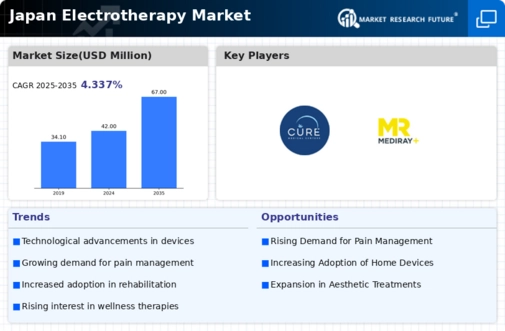Increased Focus on Rehabilitation Services
The electrotherapy market is significantly influenced by the heightened focus on rehabilitation services in Japan. As the healthcare system evolves, there is a growing recognition of the importance of rehabilitation in recovery processes, particularly for patients recovering from surgeries or injuries. Electrotherapy plays a crucial role in rehabilitation by promoting tissue healing and reducing recovery time. Recent statistics indicate that the rehabilitation sector in Japan is projected to grow at a CAGR of 5% over the next five years, further driving the demand for electrotherapy devices. This growth is likely to be supported by government initiatives aimed at improving rehabilitation services, thereby creating a favorable environment for the electrotherapy market. The increasing integration of electrotherapy into rehabilitation protocols suggests a promising future for this segment.
Rising Demand for Pain Management Solutions
The electrotherapy market in Japan is experiencing a notable increase in demand for effective pain management solutions. This trend is largely driven by the growing prevalence of chronic pain conditions among the population. According to recent data, approximately 30% of adults in Japan report experiencing chronic pain, which has led to a surge in the adoption of electrotherapy devices. These devices, which utilize electrical stimulation to alleviate pain, are becoming increasingly popular in both clinical and home settings. The electrotherapy market is thus positioned to benefit from this rising demand, as healthcare providers and patients alike seek non-invasive alternatives to traditional pain relief methods. Furthermore, the integration of advanced technologies in electrotherapy devices enhances their efficacy, making them a preferred choice for pain management in Japan.
Government Support for Healthcare Innovations
Government support for healthcare innovations is a pivotal driver of the electrotherapy market in Japan. The Japanese government has been actively promoting the adoption of advanced medical technologies, including electrotherapy devices, through various funding programs and incentives. This support is evident in initiatives aimed at enhancing healthcare accessibility and improving patient outcomes. For example, the government has allocated substantial budgets for research and development in medical technology, which includes electrotherapy solutions. As a result, manufacturers are encouraged to innovate and bring new products to market, thereby expanding the electrotherapy market. This favorable regulatory environment is likely to stimulate growth and attract investments in the sector, further solidifying Japan's position as a leader in healthcare technology.
Growing Awareness of Non-Invasive Treatment Options
There is a growing awareness of non-invasive treatment options among healthcare professionals and patients in Japan, which is positively impacting the electrotherapy market. As more individuals seek alternatives to invasive procedures, the demand for electrotherapy devices is on the rise. Educational campaigns and professional training programs are contributing to this awareness, highlighting the benefits of electrotherapy in managing various health conditions. Recent surveys indicate that over 60% of healthcare providers in Japan are now recommending electrotherapy as a viable treatment option. This shift in perception is likely to drive the adoption of electrotherapy devices across various healthcare settings, including hospitals, clinics, and home care environments. Consequently, the electrotherapy market is poised for growth as awareness continues to expand.
Technological Innovations in Electrotherapy Devices
Technological innovations are reshaping the landscape of the electrotherapy market in Japan. The introduction of advanced electrotherapy devices equipped with features such as wireless connectivity, user-friendly interfaces, and customizable treatment settings is enhancing patient experience and treatment outcomes. For instance, devices that allow remote monitoring and adjustments are becoming increasingly popular among healthcare providers. This trend is supported by a growing body of research indicating that personalized treatment plans can improve patient adherence and satisfaction. As a result, the electrotherapy market is likely to witness a surge in demand for these innovative devices, which not only improve efficacy but also align with the increasing consumer preference for technology-driven healthcare solutions.













Leave a Comment